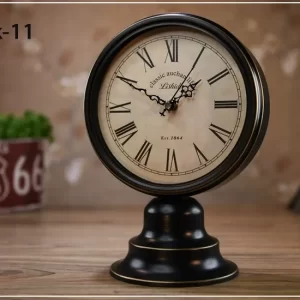A Complete Step-by-Step Guide to Replacing Clock Mechanisms
Do you have a pocket clock that has been sitting around for years, gathering dust for years? Or maybe you’re working on a new clock but aren’t sure how to choose the right movement? Repairing battery-operated wall clocks may seem difficult at first, but in reality, diagnosing and repairing these clocks can be very simple.
At MantelClock Studios, we are finding that more and more customers are coming to us with questions about identifying and replacing faulty clock parts, especially clock movements. DIY clock repairs and crafts have become very popular since the rise of various hobbies during the New Crown epidemic. Often, replacing old batteries or replacing a damaged or worn clock movement is the problem.
To make the job easier for you, we’ve created this step-by-step guide to help you diagnose and repair battery-powered wall clocks. Whether you’re repairing an old clock or starting a new project, this guide will guide you.
What is a battery-powered wall clock?
Battery-powered wall clocks use a small device (often called a clock movement , motor, or mechanism ) located on the back of the clock to keep time. Most wall clocks today are quartz clocks, which rely on quartz crystal oscillators to keep time. These oscillators regulate the time by pulses per second with great accuracy, making battery clocks more precise than traditional wind-up clocks. In addition, they remain stable in varying temperature and humidity conditions, ensuring consistent performance.
-
Elegant Black Mantel Clock for Living Room – Silent & Stylish
Original price was: $180.00.$170.00Current price is: $170.00.
Typically, clock movements can last 10 to 15 years, but some may fail prematurely due to wear, damage or corrosion. Replacing a clock mechanism is often a quick and easy repair that requires few tools, a little attention to detail, and the correct replacement parts. Follow the DIY guide below to determine the cause of the problem and fix it effectively.
Step 1: Replace the Battery
If your clock stops working, the first step is to replace the batteries. Many clocks stop working because the batteries are drained.
- Use high quality alkaline batteries for longer life and better performance.
- Locate the battery compartment on the back of the clock and carefully remove the old batteries.
- Check the battery terminals for corrosion or leakage. If you find residue, clean with a damp cotton swab or Q-tip, then dry thoroughly before installing new batteries.
Most battery-powered wall clocks require one AA battery, but those withhigh-torque movements (driving larger hands) may require one C battery. If the wall clock still does not work after replacing the batteries, proceed to the next step.
Step 2: Determine the correct clock movement
Determine whether your clock requires a standard or high-torque movement. This depends largely on the length of the minute hand.
Measurement Method:
- Measure from the center of the clock’s dial (where the hands join) to the tip of the minute hand.
- If the minute hand is longer than 150-160 millimeters, a high-torque movement is needed to drive the larger and heavier hands. If the minute hand is shorter, a standard movement will suffice.
It is also important to check whether the hands of the clock tick away (stepwise) or move continuously (sweeping). This will also affect the type of mechanism you need.
The type of movement in the clock:
- Press-in movement
- The hands are held on the shaft by friction.
- The hour hand has a circular hole and the minute hand may have a circular or hexagonal hole.
- Euro-axis movements (I-axis )
- The hour hand is attached to the shaft by a circular hole, while the minute hand has a slotted hole, flush on both sides, aligned with the shaft.
- These movements usually require a nut to hold the minute hand in place.
If you’re unsure, consider purchasing a complete replacement kit that includes new hands and a compatible movement.
Step 3: Measure the length of the shaft
The length of the shaft determines the compatibility of the movement with your clock. Shaft length is the length of the portion of the shaft that runs through the clock dial and connects to the hands.
Measurement Instructions:
- Remove the old movement.
- Measure the entire length of the shaft from the body of the movement to the tip of the shaft. Do not measure just the brass threaded portion, measure the entire length.
- The length of the shaft is usually between 7 mm and 30 mm. Make sure the shaft is long enough to pass through the dial while keeping the movement flush with the dial.
For clocks with high torque movements, shaft length options may be limited.
Step 4: Order Replacement Clock Parts
Once you have gathered all the necessary information (battery type, movement type, and shaft length), it’s time to order replacement parts. This will avoid unnecessary shipping costs due to incorrect ordering. Replacement clock parts are usually inexpensive and widely available.
At Mantel Clockworks, we also offer additional support:
- Diagnostics by mail: Send us your old clock mechanism and we will identify the correct replacement parts for you.
- On-site clockmaker service: If you don’t feel like doing it yourself, our expert clockmakers can repair it for you.
Other suggestions
If you’re not sure which parts to order, it’s a safe bet to opt for a complete replacement kit that includes new clock hands. This will simplify the installation process and avoid compatibility issues.
By following Mantel Clockworks’ guide, you can easily repair a battery-powered wall clock to get it back in working order or complete your DIY clock project. Happy clocking!
Do you need further improvements or adjustments? ### A complete step-by-step guide to replacing your clock mechanism
Brand Name: MantelClock Studio
If you own a battery-powered wall clock, you’ll find it much easier to repair than more technical clocks such ascuckoo clocks or grandfather clocks. This guide will walk you through the process of replacing a clock movement with precision and ease.
Step 5: Replacing the Clock Mechanism
If you have determined that the mechanism (movement) of your clock needs to be replaced, the first step is to remove the old movement. Although each clock is constructed slightly differently, the general structure is as follows:
- Movement Removal:
- Unscrew the movement, usually located at the front of the dial.
- Remove the back cover to expose the internal components.
- Determine if your clock has a glass lens. If it does, determine whether to remove the front bezel or access the movement from the back.
- Important Notes:
Note the space between the dial and the glass lens. Measurements will ensure that the replacement movement shaft is the correct length. A shaft that is too long may cause the clock hand to touch the glass, resulting in inaccurate timekeeping or complete malfunction.
Step 5.a: Replacing the press-in movement
Here is how to replace the press-in movement:
- Remove the mechanism from the clock frame to gain access to the hands.
- The second hand usually comes off or backs off due to friction.
- If there is a hex nut, loosen it with pliers to release the movement.
- Inspect the inside of the movement for dust or debris and clean it carefully if necessary.
- Install the new movement:
- Secure with hexagonal nuts and finger tighten.
- Reinstall the hands back into the dial, making sure they are aligned at the 12 o’clock position.
- There should be a 1 mm space between the hands so that they do not touch each other when turning.
- Replace the battery and reset the time.
Step 5.b: Replacing the European axis movement
For clocks with a European axis movement, follow the steps below:
- Remove the mechanism from the clock frame.
- Unscrew the nut on the minute hand, which is held in place by a small nut.
- Unscrew any collar holding the movement and remove the movement from the back.
- A screwdriver may be required.
- If your clock has a glass mirror, make sure the shaft length is accurate.
- Install the new movement:
- Reinstall the original collar onto the new movement.
- Reinstall it into the clock, starting with the hour hand and aligning it with the 12 o’clock position.
- Push the minute hand onto the shaft to ensure a friction fit.
- Tighten the nut and reset the time.
Step 5.c: Additional tips for replacing the clock mechanism
- Please watch the process of disassembling the clock carefully. You must reassemble it in the same order.
- Some clock mechanisms do not require screws from the front to snap into place.
- If the movement is bonded, you must take extra care when disassembling it to avoid damaging the dial.
- For German made movements such as UTS, Hermle or Junghans:
- These movements use a central retaining nut that goes through the dial from the front.
- Make sure there is a 10mm hole in the dial for proper installation.
To summarize
Follow the steps in this guide and you should now have a fully functional battery powered wall clock. Please double check the shaft length and other dimensions to ensure smooth operation. If you encounter any problems, please feel free to contact the customer service team at MantelClock Studio.
For more help, check out our detailed illustrated tutorials or watch the supplemental video tutorials below.
At MantelClock Studio, we’re here to help you make sure your clock repair experience is smooth and successful!





